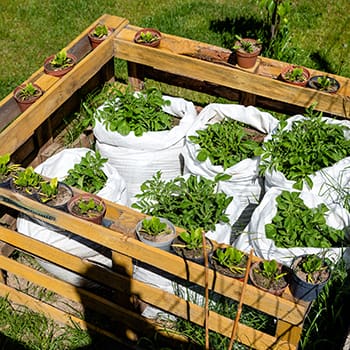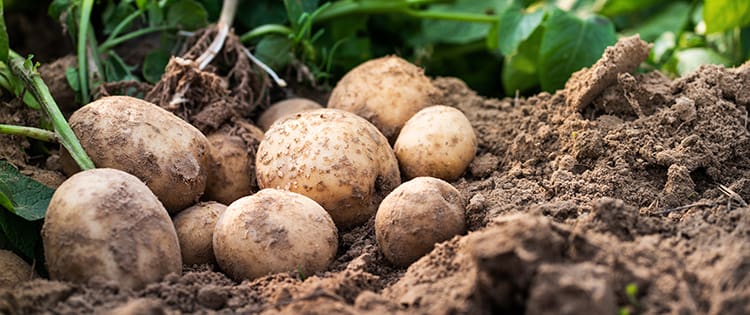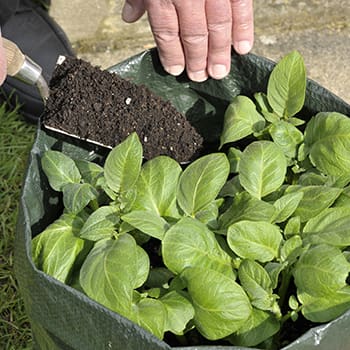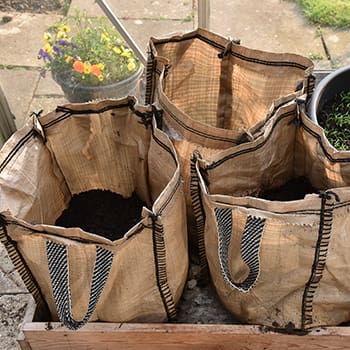If there’s one thing the Hobbits got right, it’s loving potatoes. That’s right, I’m a huge fan of a good spud or five. Probably explains why I’m not big on athletic matches, either, if we get down to it. That said, as the cost of food continues to rise, I don’t see any reason for any of you to be paying for potatoes… in the fairly near future.
Keep in mind, that this article isn’t going to have potatoes on your plate tomorrow. You’ll have to go to the grocery store for that. But, if down the road, you’d like to go ahead and start producing potatoes and have a constant supply? Well, we’ve got you covered there.
Start Right
Whether you’re doing sacks, raised beds, container gardening, in-ground gardening, or any other combination of the above, you have to start with the correct seed potatoes.
Yes, this means purchasing seed potatoes.
I know, you’re already sighing and rolling your eyes at me. I get it. I really do. I appreciate that you’re frustrated with the idea of spending even more money on something that you’re pretty sure you can just go pick right out of a gnarly bag of potatoes. We’ll talk about that in a little while, but you really can’t do that. Instead, you need to buy good, safe, well-treated seed potatoes.
Decide on your variety, buy your seed potatoes, and settle on a way to grow them. Personally, I love grow bags so I’ll assume that you’re doing grow bags in this version. However, growing a potato is very close to being the same thing throughout almost all possible growing methods. If you have specific questions remember that you can always ask us for more advice in the comments section below.
Potatoes Forever
I recommend growing double what you’ll need to feed your family for your initial batch. Why? You’ll be harvesting some of the potatoes a little bit early to start them to seed.
Grow your potatoes however you’d like. If you’re using a grow bag, you can kind of gently brush away some soil (if you’re very careful) to check on the progress of your spuds. When they’ve gotten to a size that is big enough for you (and their variety), harvest them.
For the ones that you’re taking early, chop them roughly from their mother plant and set up an egg carton in a place where it won’t be disturbed. Place each smaller potato in an egg carton cup (where the egg would normally sit) and allow them to sprout in a cool, dry area. Ideally, the room is somewhere between 60 and 75 degrees. You may rinse these potatoes to completely clear the soil from them prior to putting them in the egg carton container, but I do recommend that you don’t allow them to remain moist any longer than you must.
Related: Strange Ways to Grow Potatoes In a Tiny Space
When the potatoes begin to sprout, allow them to do so for 2-4 weeks. Why such a gap in time? Every variety of potato sprouts a little differently than the others and they all grow at different paces. Once your sprouts are numerous and at least 1″ long from the surface of the potato (ideally, pointing away from the potato) you may separate the sprouts.
Taking a very sharp knife, cut a chunk of the potato and the sprout, together, from the rest of the potato. Most seed potatoes can be used to seed 3-10 mounds of potatoes, depending on how the eyes on the potato sprout. Place these new seed potatoes in the planter, the sliced side down against the soil, and lightly pack it down. Your new potato plant will begin growing immediately.
And this is how you grow potatoes forever from your initial seed potatoes. You’ll be sacrificing some of your harvest to maintain your seed population, but it works very well so long as you have plenty of room for potatoes, or your demand is low.
What Else You Can Do
When planting potatoes, I plant them in a round. What does that mean? I plant every two weeks once I get going. This means I have a fresh batch of potatoes to harvest every two weeks, too. This means that I’m so overrun with potatoes that I haven’t bought store ones in so many years, I frequently find the idea a completely foreign concept.
You can also do this with most other types of tubers, even throughout the winter if you aren’t completely covered in snow. This includes lotus roots and even radishes (at least, most types of them).
Why You Want to Avoid Grocery Store Potatoes
Grocery store potatoes are healthy, starchy vegetables that are great for us to eat.
However, grocery store potatoes are meant for consumption, not growing. They aren’t really up for the task; that’s why there are seed potatoes on the market as well as food potatoes; it isn’t a get-rich-quick scam by the gardening companies or anyone else. In fact, some potatoes may be carrying diseases, or even communicable diseases, that could harm your garden and potential upcoming harvests. They may also have very sad failure-to-thrive experiences.
Essentially, your average grocery store potato is a culled potato from the genetic “bloodline”. It isn’t being grown for one reason or another, often because it’s better off as a meal, not nurturing the next generation of potatoes that will become meals. The last thing you want to do is grow plants that aren’t their absolute best, especially when space is tight in your garden. And if you do this right, no matter what season, your garden will be extremely tight with (and full of) potatoes.
Have you grown more potatoes than you know what to do with? Excited for far too many russets, reds, and yellows?
Tell us in the comments below if you can think of more options and reasons to keep your potatoes coming from your backyard.
We’d love to hear from you! And remember, Happy Gardening!
You may also like:
This Is The No #1 Enemy Of Potatoes
Native American Remedies That We Lost To History (Video)
10 Cooking Herbs You Should Grow In Your Garden











I am unable to plant potatoes yet but would like to be able to in the next year or two (if events allow 🙂 ) Is there a seed that can be purchased for seed potatoes? If not, how do you locate seed potatoes to purchase?
Thank you 🙂
Hi Shannon,
Yes, you can buy seed potato from most garden seed dealers, perhaps your local hardware store if they sell garden seed, gardening centers. Any store that sets up racks with garden seed will likely have bags of potato for planting. Good luck!